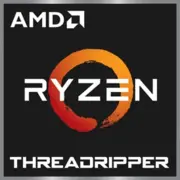AMD Ryzen Threadripper 1900X

AMD Ryzen Threadripper 1900X: A Budget Legend for Work Tasks in 2025
Introduction
Despite being released back in 2017, the AMD Ryzen Threadripper 1900X remains relevant in the budget workstation niche by 2025. With falling prices and the availability of components, it has become an attractive option for enthusiasts and professionals who need multi-threaded performance without paying a premium for the latest models. Let’s explore whether it is worth considering today and in what scenarios it can unleash its potential.
Key Specifications: Architecture and Performance
Architecture and Process Technology
The Threadripper 1900X is built on the first generation Zen microarchitecture using a 14 nm manufacturing process. It is an 8-core processor with 16 threads, which may seem modest in 2025 compared to 16-core Ryzen 7000 series or Intel Core i9-14000. However, its key feature is the Socket TR4 (SP3r2) platform, which supports up to 64 PCIe 3.0 lanes, making it useful for builds with multiple GPUs or NVMe drives.
Performance
- Geekbench 6: 1171 (Single-Core), 5905 (Multi-Core).
In comparison, the Ryzen 5 7600X (2023) scores around ~2500 points in Single-Core tasks, but the Threadripper excels in multi-threaded workloads thanks to its PCIe device support and cache.
- L3 Cache: 16 MB — sufficient for data processing in rendering or virtualization.
Key Features:
- Unlocked multiplier for overclocking.
- Support for quad-channel DDR4 memory.
- TDP of 180 W — requires serious cooling.
Compatible Motherboards
Socket and Chipsets
The Threadripper 1900X employs the TR4 socket, compatible only with the X399 chipset. By 2025, new motherboards for this socket are not being released, but models like the ASUS ROG Zenith Extreme or MSI X399 SLI Plus can still be found on the market (prices: $150-250 for new stock).
Selection Considerations:
1. VRM Module: Due to the high TDP, the motherboard should have a robust heatsink and an 8-phase power system.
2. PCIe 3.0: It does not support PCIe 4.0/5.0, limiting the speed of modern SSDs and GPUs.
3. 4 Memory Slots: For optimal performance, use 4 identical DDR4 modules.
Tip: If you can’t find a new motherboard, check warranties on used options — they often survive multiple upgrades.
Supported Memory: DDR4
The Threadripper 1900X only works with DDR4. Recommendations:
- Frequency: Optimal is 2933–3200 MHz. Higher frequencies may require manual tuning of timings.
- Capacity: Up to 128 GB (4×32 GB). For work tasks (like 3D rendering in Blender), 64 GB is preferable.
- Dual-Rank Modules: Increase bandwidth in quad-channel mode.
Example: G.Skill Trident Z RGB 64 GB kit (4×16 GB, 3200 MHz) — $220.
Power Supplies: Power Calculation
With a TDP of 180 W and the requirement for stable power:
- Minimum: 600 W (for a system without a discrete GPU).
- Recommended: 750–850 W (considering GPUs like NVIDIA RTX 4070 or AMD RX 7700 XT).
- Critically Important: A power supply with 80+ Gold/Platinum certification (for example, Corsair RM850x — $140).
Beginner's Mistake: Using cheap PSUs can lead to overheating and voltage drops, especially when overclocking.
Pros and Cons
Pros:
- Price: New processors can be found for $200-250 (in 2025).
- Scalability: 64 PCIe 3.0 lanes for multi-drive configurations.
- Overclocking: With good cooling, it can reach 4.2 GHz on all cores.
Cons:
- Energy Efficiency: 14 nm vs. 5 nm in Ryzen 8000 — high power consumption.
- Lack of PCIe 4.0/5.0: A Samsung 990 Pro SSD will operate at half speed.
- Limited Support: New technologies, such as AVX-512, are not available.
Use Cases
1. Work Tasks:
- 3D Rendering: In V-Ray or Cinema 4D, 8 cores handle medium complexity projects.
- Virtualization: 16 threads allow running multiple virtual machines.
- Video Encoding: HandBrake shows results comparable to Core i7-12700K.
2. Gaming:
- At Full HD (for example, Cyberpunk 2077), the processor is limited by Single-Core performance — average FPS is about 20% lower than that of the Ryzen 5 7600X.
- Streaming: With extra threads, the load is distributed better compared to 6-core CPUs.
3. Multimedia:
- Editing in DaVinci Resolve is comfortable, but rendering complex effects requires patience.
Comparison with Competitors
1. Intel Core i9-9900K (8/16):
- Intel Pros: Better Single-Core performance (+15% in gaming).
- Intel Cons: Lacks quad-channel memory and PCIe 3.0 x16.
2. Ryzen 7 5700X (8/16):
- Ryzen Pros: 7 nm, PCIe 4.0 support, energy efficiency.
- Ryzen Cons: Only 24 PCIe lanes.
Conclusion: The Threadripper 1900X wins in tasks where scalability is critical but falls short in energy efficiency and single-core performance.
Practical Assembly Tips
1. Cooling:
- Coolers supporting TR4: Noctua NH-U14S TR4 ($80).
- Liquid Cooling: Arctic Liquid Freezer II 280 — but check compatibility with the case.
2. Case: Choose models with good ventilation (e.g., Fractal Design Meshify 2).
3. SSD: Use PCIe 3.0 NVMe (e.g., WD Blue SN580 1 TB — $90).
4. Overclocking: Keep voltage below 1.4 V, frequencies up to 4.1–4.2 GHz.
Final Verdict: Who Should Consider the Threadripper 1900X?
This processor is worth considering for:
- Budget Studios: For editing and rendering without investing in a new platform.
- Enthusiasts: Who want to build a versatile system with 2-3 GPUs.
- Owners of Old TR4 Boards: Upgrading from Threadripper 1920X will yield efficiency gains.
Why Not To Buy: If you need PCIe 5.0, low power consumption, or maximum FPS in gaming — look to the Ryzen 5 8600G or Intel Core i5-14600K.
The Threadripper 1900X in 2025 is a homage to the old school that can still surprise in performance when wielded by an experienced user.
Basic
CPU Specifications
Memory Specifications
GPU Specifications
Miscellaneous
Benchmarks
Compared to Other CPU
Share in social media
Or Link To Us
<a href="https://cputronic.com/cpu/amd-ryzen-threadripper-1900x" target="_blank">AMD Ryzen Threadripper 1900X</a>